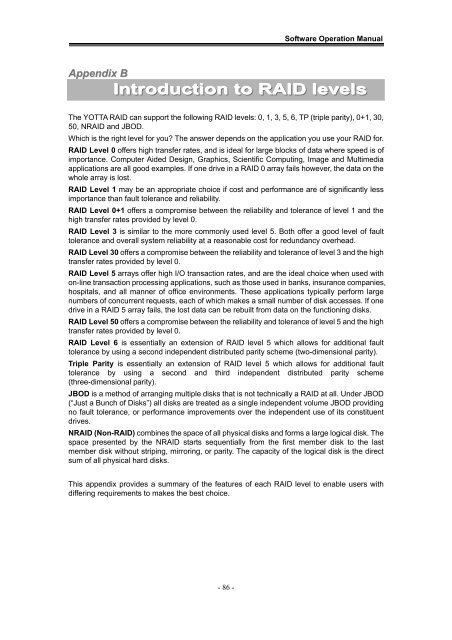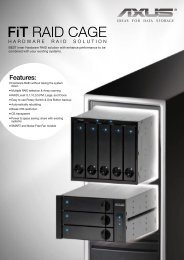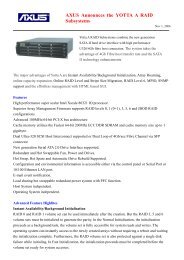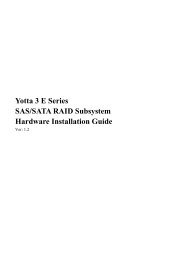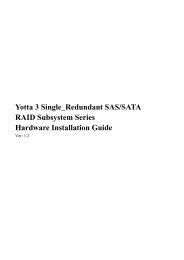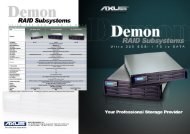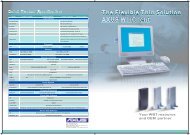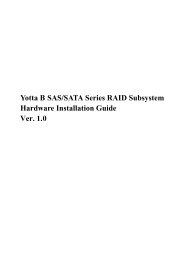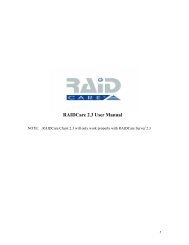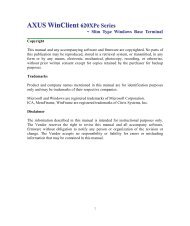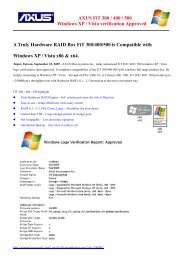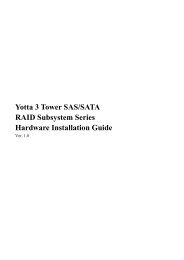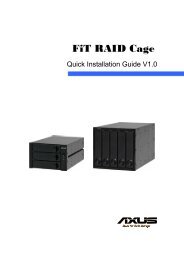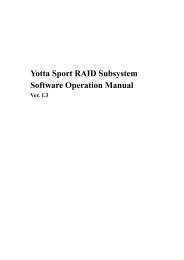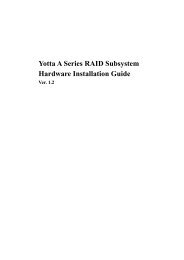Yotta RAID Software installation guide - Axus
Yotta RAID Software installation guide - Axus
Yotta RAID Software installation guide - Axus
You also want an ePaper? Increase the reach of your titles
YUMPU automatically turns print PDFs into web optimized ePapers that Google loves.
<strong>Software</strong> Operation ManualAppendix BIntroduction to <strong>RAID</strong> levelsThe YOTTA <strong>RAID</strong> can support the following <strong>RAID</strong> levels: 0, 1, 3, 5, 6, TP (triple parity), 0+1, 30,50, N<strong>RAID</strong> and JBOD.Which is the right level for you? The answer depends on the application you use your <strong>RAID</strong> for.<strong>RAID</strong> Level 0 offers high transfer rates, and is ideal for large blocks of data where speed is ofimportance. Computer Aided Design, Graphics, Scientific Computing, Image and Multimediaapplications are all good examples. If one drive in a <strong>RAID</strong> 0 array fails however, the data on thewhole array is lost.<strong>RAID</strong> Level 1 may be an appropriate choice if cost and performance are of significantly lessimportance than fault tolerance and reliability.<strong>RAID</strong> Level 0+1 offers a compromise between the reliability and tolerance of level 1 and thehigh transfer rates provided by level 0.<strong>RAID</strong> Level 3 is similar to the more commonly used level 5. Both offer a good level of faulttolerance and overall system reliability at a reasonable cost for redundancy overhead.<strong>RAID</strong> Level 30 offers a compromise between the reliability and tolerance of level 3 and the hightransfer rates provided by level 0.<strong>RAID</strong> Level 5 arrays offer high I/O transaction rates, and are the ideal choice when used withon-line transaction processing applications, such as those used in banks, insurance companies,hospitals, and all manner of office environments. These applications typically perform largenumbers of concurrent requests, each of which makes a small number of disk accesses. If onedrive in a <strong>RAID</strong> 5 array fails, the lost data can be rebuilt from data on the functioning disks.<strong>RAID</strong> Level 50 offers a compromise between the reliability and tolerance of level 5 and the hightransfer rates provided by level 0.<strong>RAID</strong> Level 6 is essentially an extension of <strong>RAID</strong> level 5 which allows for additional faulttolerance by using a second independent distributed parity scheme (two-dimensional parity).Triple Parity is essentially an extension of <strong>RAID</strong> level 5 which allows for additional faulttolerance by using a second and third independent distributed parity scheme(three-dimensional parity).JBOD is a method of arranging multiple disks that is not technically a <strong>RAID</strong> at all. Under JBOD(“Just a Bunch of Disks”) all disks are treated as a single independent volume JBOD providingno fault tolerance, or performance improvements over the independent use of its constituentdrives.N<strong>RAID</strong> (Non-<strong>RAID</strong>) combines the space of all physical disks and forms a large logical disk. Thespace presented by the N<strong>RAID</strong> starts sequentially from the first member disk to the lastmember disk without striping, mirroring, or parity. The capacity of the logical disk is the directsum of all physical hard disks.This appendix provides a summary of the features of each <strong>RAID</strong> level to enable users withdiffering requirements to makes the best choice.- 86 -


